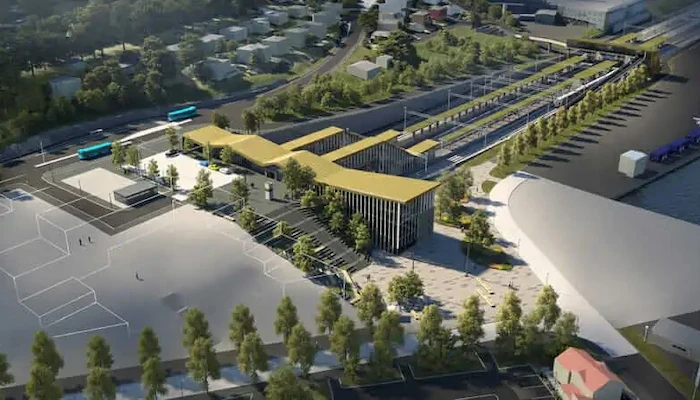& Construction

Integrated BIM tools, including Revit, AutoCAD, and Civil 3D
& Manufacturing

Professional CAD/CAM tools built on Inventor and AutoCAD
With road transport commanding more than 75% of the European freight market, the potential green benefits from shifting to rail are huge. That’s why almost every government is making train services a bigger part of the transport picture.
But for rail reliance to grow, there will need to be enough capacity to meet the rising demand—more tracks, more engines, more switches, more stations, and better services. Are rail owners up to the challenge?
The scale and complexity of transport infrastructure initiatives make bringing them to fruition extremely difficult, yet they also present opportunities for rail owners.
“Compared to road infrastructure, rail is more complex because of the safety and traffic management systems,” says Cristina Vladut, a spokesperson for the European Union Agency for Railways (ERA).
There is also a long list of stakeholders to placate, from owners to regulators, local residents living along any proposed new route, politicians, and passengers. Meeting budget, deadline, and quality targets is difficult in a sector marked by cost overruns and structural deficits in planning and execution.
Then there are skilled-labor shortages, low margins, policy clashes, and unpredictability in securing building materials. Projects can involve hundreds of contractors and subcontractors whose efforts require orchestration and coordination.
And let’s not forget the customers. Today’s travelers and shippers have had their service expectations raised by digital transformation. Passengers want glittering train stations, charging points for their gadgets, reliable Wi-Fi, easy trip planning, and e-tickets on their smartphones. Shippers want simpler processes, more flexibility and convenience, and the ability to track their consignments in real time.
Throwing sustainability into the mix makes upgraded rail networks an urgent priority, with the capacity to balance demand between people and products.
In a 2021 report, the World Economic Forum noted that in the United States, “rail freight commands a market share of more than 30%, but in Europe it’s less than 20%.” Because passenger traffic dominates European rail journeys, freight has to take what’s leftover. This affects delivery times and stops some shippers from using rail at all.
One of Europe’s biggest rail owners is grappling with these challenges by developing a strategic investment program that wraps together commercial and strategic objectives, then takes a sustainable approach to achieve them.
Deutsche Bahn’s Green Transformation initiative aims to ensure that all big decisions about the German national rail operator’s future network design—and the construction practices that deliver it—are made with green goals in mind.
The 13.6 billion-euro network improvement project is a bid to encourage travelers to take more climate-friendly rail journeys. The railway aims to modernize and renew around 1,800 km (approximately 1,100 miles) of track, 2,000 switch points, 140 bridges, and 800 stations, significantly expanding network capacity and making the existing infrastructure more efficient.
There will also be a focus on digitalization, notably with a shift to the ETCS (European Train Control System) digital control and safety system. Based on European standards, it helps rail operators overcome the problem of cross-border interoperability by making signaling, switching, and other core traffic and safety controls fully digital across Europe.
“A strong infrastructure is the basis for an attractive offer for all rail passengers,” said Ronald Pofalla, Deutsche Bahn’s director of infrastructure, in a company announcement. “We want to convince more people to use the environmentally friendly railway as a means of transport.”
In Switzerland, national rail operator SBB has undertaken a network-wide digitalization project called SmartRail 4.0. It promises pinpoint tracking of train locations in real time, enabling higher densities (more and longer trains) at peak demand times.
Planning and control of rail operations is being automated, allowing faults to be fixed faster. Automating scheduling is also improving the reliability of the overall train timetable, which helps save energy.
Rail owners also have to consider the impact of macro trends like Mobility as a Service (MaaS), which some futurists believe will define tomorrow’s transport.
MaaS envisions a unified system where trains will play their part in a range of fully interconnected modes of mobility, sharing a platform with trams, buses, cabs, carshares, and e-scooters.
You can see that vision come to life in Helsinki’s Whim system, which lets users plan and pay for all modes of public and private transportation in the Finnish capitol. It links the city’s trains and trams with buses, taxis, carshares, and bikeshares. Users download the app, create a profile, then enter a destination along with the preferred mode of reaching it. If no single mode can cover the door-to-door journey, the app suggests the best combination.
MaaS-centric strategies often go beyond railroads to encompass station buildings, retail facilities, and other facets of customers’ day-to-day lives. Take RingoPass, the new MaaS service from East Japan Railway Company (JR East)—an example of a digital transformation that benefits everyone.
“Secondary transport such as taxis and shared bicycles are part of getting from departure point to destination,” Yukiko Ono, deputy general manager of JR East’s MaaS & Suica Headquarters, told Global Insights. “So we thought we should provide the ‘flow’ to get customers through their whole journey smoothly.”
Ono explains that this kind of digital transformation is supported by top management. “In July 2018, we announced a new strategy called ‘Move UP 2027,’” she says. “It includes a commitment by our president and CEO to completely change the way we think. We want to embed innovation into the workplace.”
“We have trained our mobility behavior over generations, doing the same for 130 years,” writes Professor Andreas Herrmann, professor of business administration at the University of St. Gallen in Switzerland, and director of its Institute for Mobility (IMO-HSG).
In an IMO-HSG report titled “Why Only Collaboration Can Push Mobility as a Service to the Next Level,” Herrmann says that bringing MaaS to life will require “long-lasting efforts by all [transport industry] players to convince consumers.”
It also requires greater agility and “strategic momentum” from key industry stakeholders—rail operators included. That’s partly a call for greater technology investment. The institute notes that outdated legacy software and hardware blocks many rail companies from integrating into MaaS platforms.
In short, to take their place in transport’s connected future, rail systems need to go digital. It’s a necessary step for enabling seamless transitions in multimodal trip solutions. It can also aid the design and planning process for upgrading and expanding rail networks to meet future demand.
As in the wider AEC industry, rail is moving to greater adoption of digital tools to improve project management and delivery. Digitized workflows and building information modeling (BIM) are enabling better collaboration across the lifecycle of major infrastructure projects around the globe—from planning and design to construction and operation.
You can see digital design’s positive impact in the rollout of Bane NOR’s (Norway’s state railway) Hensetting–Østfoldbanen project. The multimillion-Krone railway extension in Oslo has been managed using finely detailed 3D maps of the 2.2 km (1.3 mile) path the new tracks will take.
Accurate to within 20 cm, the maps include data on 35,000 trees—a crucial talking point for residents living in the vicinity of the build. The maps also simplify the process of charting a phased course of construction through the most densely populated land in Norway.
Created using a blend of BIM and geographic information system (GIS) data, lead engineering firm Ramboll credits the digital maps with enabling better communication with clients and partners because every stakeholder could make decisions from the same single source of information.
A key stakeholder for any rail network upgrade is the general public, particularly people affected by an expanded rail route. For another of its expansion projects, Bane NOR is using immersive design and virtual reality to secure buy-in and put local residents’ minds at ease.
“We set up a showroom in the city where the public can come to view the project in a theater setting, and the feedback has been quite nice,” says Hans Petter Sjøen, facility management coordinator for Bane NOR. “People have been receptive. They tell us that they have seen dimensions on the big screen that they could not see in person.”
Is this a snapshot of rail’s future? From BIM to smartphones to 5G networks, the technologies needed to weave together a green digital infrastructure are already here. The world is ready for better trains and better transport—it’s up to the industry to find a common strategy for making it a reality.
Mark de Wolf is a freelance journalist and award-winning copywriter specializing in technology stories. Born in Toronto. Made in London. Based in Zürich. Reach him at markdewolf.com.
AECO
AECO
AECO








